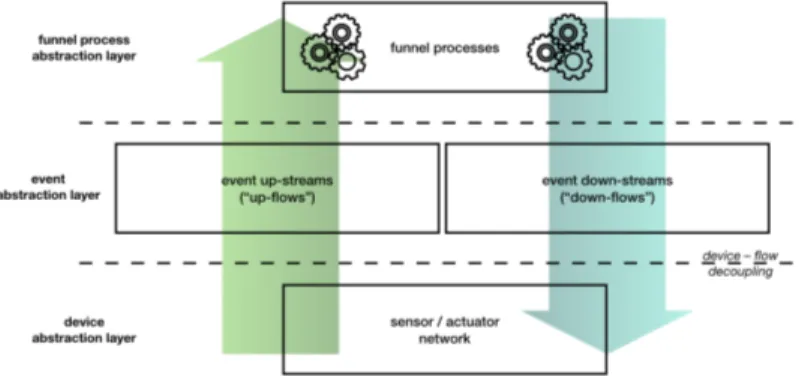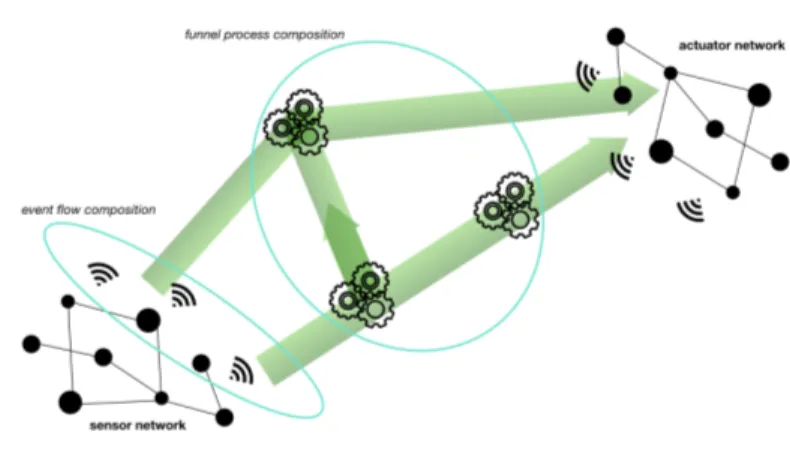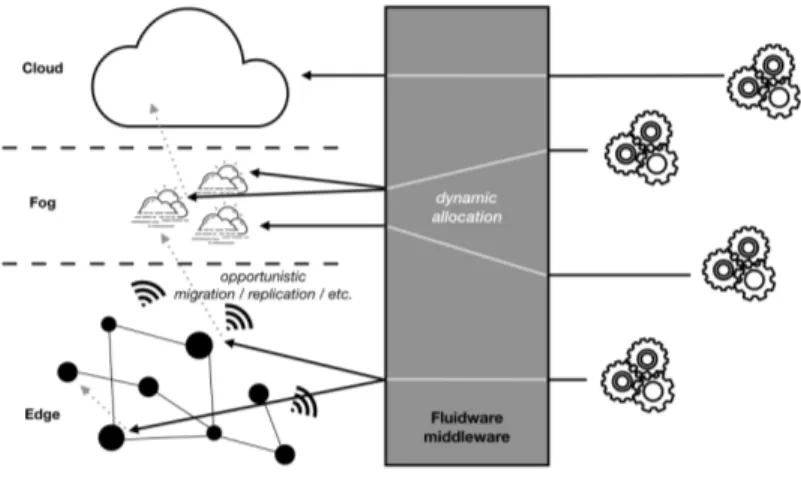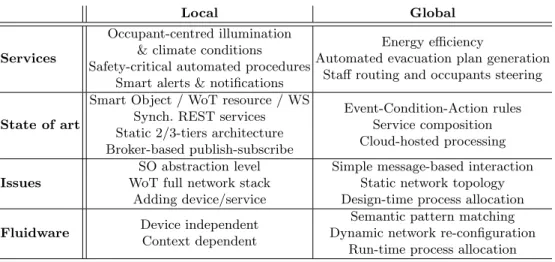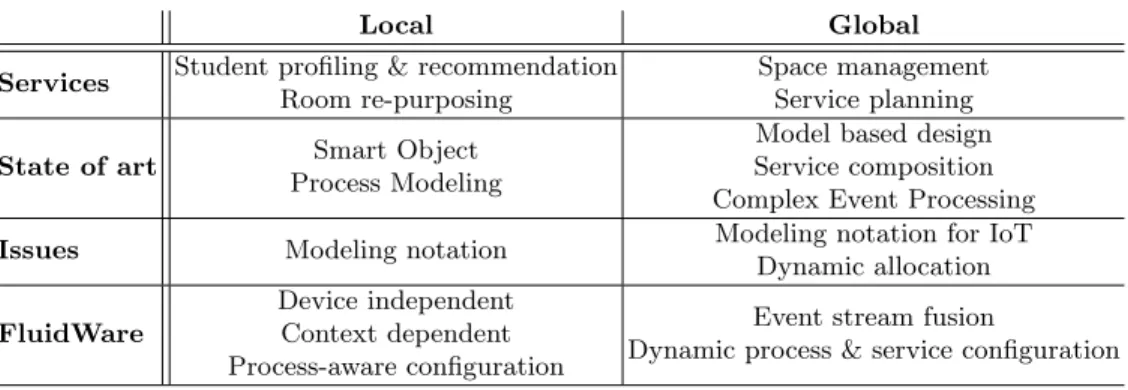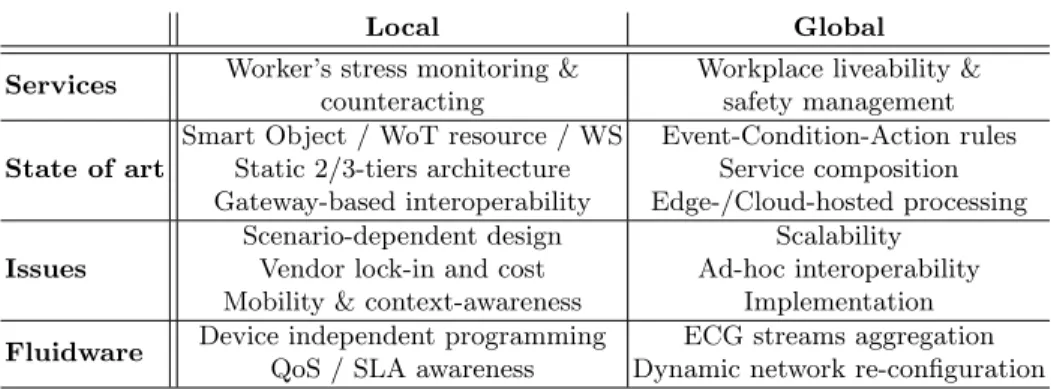paradigm: Fluidware
?Stefano Mariani1, Roberto Casadei2, Fabrizio Fornari3, Giancarlo Fortino4, Danilo Pianini2, Barbara Re3, Wilma Russo4, Claudio Savaglio4, Mirko Viroli2,
and Franco Zambonelli1
1
DISMI, University of Modena and Reggio Emilia {stefano.mariani, franco.zambonelli}@unimore.it
2
DISI, University of Bologna
{roby.casadei, danilo.pianini, mirko.viroli}@unibo.it
3
School of Science and Technology, University of Camerino {fabrizio.fornari, barbara.re}@unicam.it
4
DIMES, University of Calabria
{g.fortino, w.russo}@unical.it, [email protected]
Abstract. A number of scientific and technological advancements en-abled turning the Internet of Things vision into reality. However, there is still a bottleneck in designing and developing IoT applications and ser-vices: each device has to be programmed individually, and services are deployed to specific devices. The Fluidware approach advocates that to truly scale and raise the level of abstraction a novel perspective is needed, focussing on device ensembles and dynamic allocation of resources. In this paper, we motivate the need for such a paradigm shift through three case studies emphasising a mismatch between state of art solutions and desired properties to achieve.
Keywords: Fluidware · IoT programming · coordination.
1
Introduction
To reveal the full potential of large-scale IoT deployments demands for novel models and programming abstractions [6, 22]. The need to adapt to short, medium, and long-term contingencies, to operate on a dynamically evolving infrastructure comprising the full spectrum of Edge, Fog, and Cloud devices and resources, to react to the inner dynamics of the environment (there including the space-time fabric) in near real-time, and to execute goal-oriented orchestration of distributed activities across devices (with a varying degree of computational power), raises challenges yet to be addressed by currently available programming languages and executing platforms [22, 16, 14].
?Work Supported by the Italian MIUR, PRIN 2017 Project “Fluidware”.
Copyright c 2019 for this paper by its authors. Use permitted under Creative Com-mons License Attribution 4.0 International (CC BY 4.0)
A novel programming model for IoT services and applications has been conceived in [8] with the purpose of tackling the aforementioned challenges: grounded on results in the areas of attribute-based coordination [1, 2, 7], field-based coordination [13, 21], collective adaptive systems [4, 18], and aggregate com-puting [5, 6], the proposed “Fluidware” framework aims to address the complex-ity of designing and deploying large-scale IoT systems. Fluidware revolves around the core idea of abstracting away devices of the IoT fabric (sensors, actuators, gateways, etc.) as sources, digesters, and targets of distributed flows of contex-tualised events delivering information about data produced, manipulated, and consumed, over time and across space. Programming services and applications then amounts at designing “funnel processes” to capture, process, manipulate, and route such flows in a fully distributed way, as a means to coordinate the ac-tivities of devices towards achievement of system (application or service) goals. Funnel processes are declarative specifications defining what event flows to con-sume and produce over time and across space, operating on distributed and contextualised event streams in terms of pattern-matching mechanisms consid-ering both semantics of data and space-time constraints.
In this paper we advocate the need for such a paradigm shift in designing and developing IoT services and applications by discussing three envisioned de-ployment scenarios: a smart retirement centre, a smart university campus, and a generic stress-free workplace. Accordingly, the paper is organised as follows: Sec-tion 2 overviews the Fluidware approach to IoT systems engineering; SecSec-tion 3 describes the issues in developing IoT services according to current practice, and how Fluidware may overcome them, in a smart retirement centre scenario, whereas Sections 4 and 5 do the same for a university campus and a generic workplace, respectively; finally, Section 6 provides final remarks.
2
Fluidware
The key idea of Fluidware is that IoT services and applications can be conceived and designed as transformations of widely distributed event streams (“flows”) encompassing ensembles of devices. This is achieved by means of the “funnel pro-cess” abstraction, acting as both producer and consumer of flows, and able to capture, merge, split, replicate, redirect, filter, process, namely manipulate them in time and space, over the network of distributed IoT devices, and ranging the whole spectrum from Edge to Cloud. As a consequence, Fluidware raises the abstraction level for developers willing to design an IoT service or application: they no longer think in terms of programming physical devices and orchestrat-ing their communications, but rather in terms of programmorchestrat-ing purely logical processes (the funnels) dealing with event streams detached from the physical devices actually producing and consuming them—as depicted in Figure 1.
Funnel processes are declaratively specified in a totally agnostic and orthog-onal way with respect to their actual allocation to computatiorthog-onal nodes, and distribution across the Edge-Cloud spectrum—which are aspects delegated to the Fluidware middleware. Such a specification defines which flows to capture
Fig. 1. Fluidware approach: devices are abstracted away as sources and targets of event flows, captured and manipulated by funnel processes.
and what to get out of them depending on contextual, spatio-temporal, and se-mantic constraints (e.g., “gather all temperatures from this area in the last 15 mins which are above the defined critical threshold, then chart a heatmap”). This enables to define scale-independent computational processes inherently to contextual conditions and seamlessly fitting heterogeneous computing and net-work infrastructures. More specifically, an event flow is manipulated by funnel processes to produce a new flow, by a combination of techniques typical of stream processing and self-organising systems, such as merging, splitting, filtering, ag-gregation, spreading, and so on [20]. Funnel processes may work as filters, se-lecting events from flows if and only if they match semantic and spatio-temporal criteria defined by a suitable Domain Specific Language (e.g. as for Regular Ex-pressions); aggregators, to fuse different event flows into new ones, depending on how their attributes relate to each other, so as to change the structure of the flow (e.g. summarising information by averaging data); transmuters, that modify the content of events in flows, leaving the structure unchanged (e.g. resetting coun-ters for a “rolling horizon” measure); roucoun-ters, that may re-locate, grow, shrink, etc. the span of events in the space-time fabric (e.g. moving a source of events to a more reliable device). Basic primitive operators will take care of manipulating event flows and funnel processes as well, as a higher order calculus, such as split-ters and mergers to manipulate cardinality of input and output streams, pipes and multiplexers to handle sequential and parallel composition of streams and funnels, etc. As an example, the following pseudo-code snippet may implement the aforementioned “heatmap charting” funnel:
function critical temp nearby:
if temp(bind-to [area(here), last(15,0m0)]) > thresholds(0temp0) then end if
sys.viz.chart(0heatmap0, temp) end function
Fig. 2. “Funnels” opportunistically capture “flows” as well as compose with each other.
Indeed, a suitable platform/middleware [16] is a key enabler of the Fluidware approach, as the responsible for the actual allocation of funnel processes at the more appropriate layer of an Edge-Fog-Cloud network of devices and com-putational nodes [19], as well as of their optimised execution and transparent replication/relocation across the network. The Fluidware middleware will thus take care of performing two critical kinds of decision during run-time, both with the goal of fully realising the funnel processes specification: (a) which flows to connect to a given funnel process (e.g., all flows in target area, only flows with certain properties, etc.), and how (e.g., as a message stream, through a publish-subscribe blackboard, or with a tuple space), and (b) where to deploy such a process (e.g., at the Edge, in the Fog, or on the Cloud), and how (e.g., as indi-vidual process, or as part of a swarm of distributed replicas, or as a worker in a map-reduce like architecture).
For instance, a funnel process collecting temperature measures from a given area to chart a heatmap of that area may be actually composed by three sub-processes: one gathering temperatures from sensors, thus directly deployed on-board Edge devices, one aggregating results to average out temperatures depend-ing on sub-areas (e.g., the kitchen, the livdepend-ing room, 1st floor, 2nd floor, left-wdepend-ing, right-wing, etc.), hence deployed in Fog gateways, and the last one charting the heatmap, deployed on the Cloud (as it needs global information and more compu-tational capacity). Such sub-processes, which can be funnel processes themselves, are opportunistically connected to the most suitable event flows (Figure 2), and deployed to the most suitable device (Figure 3). For instance, should the Fluid-ware middleFluid-ware detect failure of a sensor, it could replace the connection to the event flow coming from such sensor with another, non faulty one. Also, should the middleware detect a performance drop in processing at the Edge, it could decide to re-locate the correspondent sub-process to an available Fog gateway.
In next sections, we discuss three Fluidware deployment scenarios so as to shed light on why the kind of paradigm shift proposed by Fluidware is needed,
how it advances beyond the current state of art in delivering services in the IoT, and what benefits it delivers.
3
Smart Retirement Centre
We envision the scenario of a retirement facility for elderly people or people with chronic diseases, both requiring peculiar care and continuous assistance. There, we assume guests can live together with a member of their family or an assistant (social worker, nurse) in small furnished flats, properly equipped with IoT devices and services meant to support health and general lifestyle monitoring (e.g., smart cameras, A/C, illumination, doors, etc.). Also, we assume that the centre has dedicated rooms for providing care to guests (e.g., rehabilitation rooms and spa services) as well as rooms for social and leisure activities (e.g., the canteen, and common living rooms), also equipped with smart devices (e.g., smart TVs, pill boxes, refrigerators, beds, sofas, chairs and wheelchairs, etc.).
Several specific IoT services can be delivered to guests, which usually require coordination of several components (software and hardware), and each having its solutions and issues to deal with—as summarised in Table 1.
3.1 Services
In the flats of the facility, other than services to access and control individual appliances, one can think at providing coordinated services that, by accessing and directing the lightening system, the light sensors, and the window curtains in a specific room, can modify the overall light situation of that room depending on the specific needs/preferences of the persons occupying it. Similarly, sensors
and actuators associated to the heating and A/C systems can set up the climate conditions in accord to the specific comfort levels of the inhabitants.
Concerning care delivery, one can think at services to monitor the health con-ditions of patients and their everyday activities, and possibly send notifications to the medical personnel to alert about unusual or potentially safety-critical situations. Furthermore, in presence of suitable actuators (e.g, robotic personal assistants or properly instrumented furniture such as electro-mechanical beds and sofas) the system can directly trigger the necessary actions to prevent dam-age (e.g.,, put the bed in vertical position upon sensing choking). All of the aforementioned IoT services are local in the sense that they do not require a global understanding of the situation.
In addition to the local services conceived to orchestrate specific portions of the facility, a number of global ones can be envisioned to regulate its overall functioning. For instance, services to control the heating and lightening systems, and in particular to monitor and keep under control energy expenses. Services to monitor fire and other dangerous situations, and automatically organise evac-uation plans upon need. Services to control the overall distribution of people in the facility and steer assistance personnel accordingly.
3.2 IoT devices
In order to set up the aforementioned services, the following sensors and actua-tors are needed:
– general ambient sensors and actuators: light and heat controllers, gas and smoke detectors, presence and motion sensors, energy consumption sensors on electric appliances, shutter/curtain controllers, as well as daily life objects augmented with sensing capabilities (e.g, cup, fork, cane).
Table 1. Smart retirement centre services and related state of art solutions issues.
Local Global
Services
Occupant-centred illumination & climate conditions Safety-critical automated procedures
Smart alerts & notifications
Energy efficiency
Automated evacuation plan generation Staff routing and occupants steering
State of art
Smart Object / WoT resource / WS Synch. REST services Static 2/3-tiers architecture Broker-based publish-subscribe Event-Condition-Action rules Service composition Cloud-hosted processing Issues SO abstraction level WoT full network stack
Adding device/service
Simple message-based interaction Static network topology Design-time process allocation
Fluidware Device independent
Context dependent
Semantic pattern matching Dynamic network re-configuration
– specific sensors and actuators needed to monitor and assist with the health conditions peculiar to each guest, there including body sensors such as heart rate, glucose, blood pressure, temperature, or medical devices such as ECG monitors, sleep quality monitors, spyrometry devices, smart scales.
Besides devices inside guests’ flats, all other places in the facility may include sensors to detect people presence and ambient conditions, actuators to regulate ambient conditions, and digital signals (e.g., audio system) or screens to provide notifications, messages, and alerts.
3.3 State of art solutions
At the modelling level, solutions readily available to deliver the aforementioned services are either based on the concept of Smart Object (SO) [11], on the Web of Things vision (WoT) [9], or on service-orientation. From the architectural standpoint, service-oriented architectures (SOA) [17] are most prominent, as the service abstraction can span the whole spectrum of Edge-Fog-Cloud layers typi-cally featured in modern IoT deployments. Also, SOA is a good fit for both SO and WoT modelling. A the infrastructural level, the 2/3-tiers model encompass-ing the whole network of devices from the Edge to the Cloud (possibly includencompass-ing Fog nodes) is the most popular right now, as it enables system administrators to deploy each service at the most appropriate location [12].
The above considerations imply that, for instance, realising services for moni-toring patient clinical conditions and trigger appropriate action in case anomalies are detected would amount, essentially, at developing a web services stack for data processing and the appropriate communications with sensor and actuator devices. For instance, these may be connected to a local gateway (e.g., a RasPi or a desktop computer) for sending data, which is then processed by an ensemble of web services to realise the system functionalities. Cooperation between services may happen in a point-to-point fashion through simple RESTful endpoints, or by relying on a publish-subscribe broker. Finally, deployment would be mostly decided at design-time: the web service backends would be likely deployed on the Cloud, or possibly to a sufficient powerful Fog node, and devices connected to the gateway would have their own logic embedded to send data and listen for commands. This practice limits scalabilty as forces developers to individually deal with each specific device individually.
3.4 Issues
The solutions described above have a few limitations which current research pro-posals fail to address in a holistic and conceptually sound way. WoT modelling requires a full network stack to be available on connected devices, which is im-practical for the resource-constrained ones usually employed at the Edge. SOA does not cope well with moving services across tiers’ boundaries depending on available resources. The 2/3-tiered network topology model is usually accepted as a static one, where services are allocated to one specific tier at design time.
This means that, for instance, adding a new device to the system usually implies adding a new service to the stack, taking care of connecting the device to the rest of the application, re-wiring service composition routing paths, and such. Also, scaling the service to, for instance, a whole flat instead of a single room usually requires a re-deployment of the whole application.
3.5 Fluidware approach
Fluidware would enable developers to define the event streams they are inter-ested in (e.g., the blood pressure or heart rate time series), the funnel processes they want to deploy (e.g., one triggering alerts if a combination of vital signs is worsening, and another one gathering vital signs measurements from body sensors) and how they combine the aforementioned streams, and let the Fluid-ware middleFluid-ware taking care of (a) connecting the event streams to the actual source devices’ data, and (b) allocating the funnel processes to the computa-tional nodes composing the network. This means that developers need no longer to bother with re-wiring service connections if new applications are deployed, or to re-configure the network topology if new devices come in, nor to deal with device failures as long as other providing the same data are available.
Overall, this means that not only system designers have an higher abstraction level provided, but also a higher degree of decoupling between system hardware and software components. With Fluidware, indeed, “flows” decouple computa-tional processes from the actual data sources they need, while “funnels” decouple developers from the burden of statically deciding where to deploy their services.
4
Smart University Campus
Another scenario suitable for Fluidware is a smart university campus, as it should provide comfortable living spaces for both students and faculty staff to support individual studies and research, as well as student teamwork and staff collabo-rative research. There, spaces could be re-organised on a per-need basis, such as in the case of planned temporary events (e.g., meetings, conferences, seminars, industry recruiting, etc.) or unexpected contingencies. For instance the earth-quake of October 2016 seriously damaged the whole city centre of Camerino, causing damage to buildings of the Department of Computer Science, among the many. In presence of scarcity of space, organisation is thus even more critical, and opportunistic exploitation of available rooms is of paramount importance. Several services can then be conceived to deal with the shortage of spaces—as summarised in Table 2.
4.1 Services
A first service that can be delivered to students and faculty staff is the real-time (a) tracking of rooms occupancy and (b) adjustment of rooms’ environmental conditions to the occupants’ needs. At the local level, students, researchers, and
professors may utilise a smartphone app indicating the place that better matches the users’ requirements: for instance, some students require a study place which is isolated, quiet, warm, and bright, whereas others are just interested in finding the closest spot. At the global level, administration staff and campus managers may find convenient to have a Decision Support System for governance, aimed at analysing data generated from the university IoT infrastructure to better understand how to allocate the available spaces and to find the most suitable spaces for locating new services.
Another service could be a navigation system to steer people towards their destination, featuring integrated contextual information such as current or future crowded areas, planned events, etc. Different path optimisation methods (e.g., the shortest distance, the shortest time, accessible paths only, stairs minimisa-tion, etc.) can be applied according to individual preferences and conditions. Another example is assisted parking: free parking slots (for cars or bikes) can be suggested according to planned activities of individuals; for instance, slots nearby the branch of the campus where activities will be located could be prioritised.
Lastly, an interesting service would be a recommendation system informing about opportunities of interaction and activities contextual to students’ and researchers’ goals and preferences. For example, in a multi-disciplinary campus, students may grow interest in seminars or events which belong to different degree courses; in these cases, it may be easy not to get appropriately notified. If the campus is big enough, it is also likely the opposite happens: students receive so many notifications about upcoming events that they simply ignore them all. In this case, the recommender system should be able to customise the information conveyed to each student, dynamically considering dominating interests, as well as maximising the interests of groups, as people are more likely to attend an event if an entire group is involved.
4.2 IoT devices
Several devices have to be scattered across the campus to support the aforemen-tioned services: presence and motion sensors; temperature, humidity, light, and
Table 2. Smart university campus services and related state of art solutions issues.
Local Global
Services Student profiling & recommendation Room re-purposing
Space management Service planning
State of art Smart Object
Process Modeling
Model based design Service composition Complex Event Processing
Issues Modeling notation Modeling notation for IoT
Dynamic allocation FluidWare
Device independent Context dependent Process-aware configuration
Event stream fusion
noise sensors; RFID tags and readers; cameras; electric actuators; Edge devices such as single-board computers (e.g., Raspberry Pi). These devices will not form a finite and static set, immutable for the whole services lifetime: instead, it can dynamically change for device addition or failure and replacement. Moreover, it is worth emphasising that students and faculty staff, too, can serve as crowd-sensing sources sharing data through their own personal devices, for instance by simply accepting to communicate their position to the smart campus services.
4.3 State of art solutions
Several techniques are available for designing the aforementioned functionalities, however, none of them takes a holistic stance, which is instead quintessential for a system where decisions depend on a variety of factors. Also, existing solutions do normally require to send data through the Cloud to third parties, which can be undesirable. From the point of view of the developers, traditional approaches such as object orientation or web services quick fall short in terms of expressive-ness, extendability, and integration in such highly and heterogeneous scenarios such as the IoT.
4.4 Issues
Using graphical notations for representing processes is a well-known practice in the areas of Model-driven engineering and Business Process Management (BPM). For instance, in our scenario we can represent processes for the search of a room, the information retrieval from sensors, the analysis of sensors infor-mation, the activation of sensors failure procedures, the engagement of users and their devices in the data retrieval procedure. However it is challenging to capture all the required details about sensors and smart devices with the actu-ally available notations (e.g., BPMN). Especiactu-ally, there is no standard way to represent an IoT device, and data are generally represented by a single element called data-objects. No support is given for the concept of flow/streaming of data which are necessary in many IoT deployments.
4.5 Fluidware approach
The objective of Fluidware funnel processes is to leverage on sensors oppor-tunistically, so as to enable seamless provisioning of timely and reliable data for supporting the services offered to users. We may conceive a fluid process in two way: on one side, a top-down approach can be used by designing all the process variations that may be activated in some circumstances, whereas on the other side a bottom-up approach based on mining techniques can be used to discover relevant emerging processes. We could of course also think about a mixed ap-proach. In any case, the activated processes are strongly dependent from sensors data, which means the processes are differentiated in terms of control-flow but also in terms of data-flow, which is something Fluidware can nicely support thanks to device decoupling and dynamic resource allocation.
Table 3. Stress-free workplace services and related state of art solutions issues.
Local Global
Services Worker’s stress monitoring & counteracting
Workplace liveability & safety management State of art
Smart Object / WoT resource / WS Static 2/3-tiers architecture Gateway-based interoperability Event-Condition-Action rules Service composition Edge-/Cloud-hosted processing Issues Scenario-dependent design Vendor lock-in and cost Mobility & context-awareness
Scalability Ad-hoc interoperability
Implementation Fluidware Device independent programming
QoS / SLA awareness
ECG streams aggregation Dynamic network re-configuration
As sensors and actuators can dynamically change, the decoupling between devices and data flows offered by Fluidware becomes of paramount importance. E.g., if each student has a dedicated application on his smartphone, hence is working as a crowdsensing source, as he/she moves around the campus the information that his/her smartphone provides changes context, hence may be opportunistically connected to another funnel process by the Fluidware middle-ware. Not only connection between event flows and funnel processes may change, but also allocation of such processes across the IoT network can: for instance, funnel process may migrate across Fog nodes (e.g., RasPis deployed in strategic positions across the Campus) with the goal of minimising latency in delivering services to students and researchers.
5
Stress-free Workplace
Overworking, conflicting relationships, psychological harassment, etc., contribute to workplaces stress, with negative impacts on workers’ productivity and, espe-cially, health. Cardiac monitoring is a key activity to detect high-stress condi-tions and the ECG monitoring has become one mainstream activity in ambient assisted living. A variety of services may be engineered to relieve workers and to help the governance to manage stressful collective situations (e.g., noisy of-fice rooms, dangerously overcrowded canteen, etc.) while improving the livability and safety of the workplace.
5.1 Services
At a local level, a cardiac monitoring IoT service can acquire the real-time ECG of a single user from a worn chest band, process the received heart signals, and enable the individual HRV analysis. Eventually, doctors and psychologists can outline the stress profile of the monitored individual and take actions to preserve worker safety and well-being (e.g., notify a worker to take a break).
At the global level, instead, the IoT service can exploit distributed acquisition of ECG flows related to several monitored workers. In this case, a multi-user stress monitoring, along with other contextualised data, allows the workplace governance to identify both common uncomfortable situations (e.g., a noisy office room) and episodic dangerous ones (e.g., an overcrowded parking slot). There-fore, situations threatening the workplace livability and safety can be properly managed through immediate actuation (e.g., opening a window) or plan future actions (e.g., re-thinking distribution of parking spaces).
5.2 IoT devices
The envisioned stress monitoring service would hence need wearable, specific-purpose devices, such as Polar H10 chest band, for the heart signal acquisition and the Bluetooth-based communication to the user smartwatch/smartphone; portable, general-purpose devices, such as Android-based smartwatches Huawei Watch2, to be interfaced with the wearables; a single-board computer (e.g., Rasp-berry Pi3, Zotac CI540 NANO Pc, etc.) acting as a gateway for collecting and locally processing ECG data. These IoT devices are all commercially available and affordable. Besides these devices, the monitored workplace might include sensors to detect people presence and ambient conditions, actuators to regulate ambient conditions, and the like.
5.3 State of art solutions
Conventional ECG-based stress monitoring systems are typically designed for a single, specific (indoor or outdoor) setting provided with a set of (both fixed and mobile) physiological and wearable devices [10], considered as Smart Objects (SOs) [11] which can be accessed and controlled through the Web in the Web of Things vision (WoT) [9]. Cloud-based, Edge-based or hybrid solutions are chosen according to the specific requirements (real-time, costs, mobility, etc.) of a given scenario [15]. Private/public Cloud platforms typically support the system to store and process the data while lighter tasks are performed directly at the Edge. Gateways are often exploited to overcome the heterogeneity of communication protocols adopted by the different devices. Service composition typically happens in a point-to-point fashion through simple RESTful endpoints, with interactions statically defined by Event Condition Action rules [3].
5.4 Issues
The aforementioned solutions are typically tailored on a single, well-defined sce-nario (e.g., a highly instrumented infrastructure of an office room) and do not effectively handle the gradual transition between different environments. De-vice/worker mobility introduces the need for the seamless, dynamic execution of computational task according to changes in the devices’ availability (e.g., a worker’s smartphone might run out of battery and be automatically replaced
by the smartwatch). Ad-hoc mechanisms are also typically provided to make heterogeneous devices interoperable (software bridges, data model translators, etc.), but these solutions often result in not scalable architectures, difficult to be extended. maintained, and upgraded in the future.
5.5 Fluidware approach
The Fluidware approach allows overcoming many of the aforementioned limi-tations. Being device independent, Fluidware does not assume the existence of specific types of devices in specific locations: this allows continuous and mobile monitoring of the workers, thus enabling the ECG-based stress monitoring sys-tem to (a) adaptively and reliably serve its purpose, despite contingencies like unreachable devices; (b) dynamically integrate new devices; (c) support seman-tic interoperability specifying the event/data flow in a declarative way. Indeed, Fluidware design and programming abstractions natively and seamlessly support Edge to Cloud computations, thus fostering the development of a scalable ECG-based stress monitoring system which adapts to the application requirements (ECG acquisition responsiveness, HRV calculation accuracy, etc.).
6
Conclusion
In this paper we discussed three case studies motivating the need for a paradigm shift in engineering and programming IoT services and applications. Such a paradigm shift is actually envisioned by the Fluidware approach already pre-sented in [8], which we here conceptually evaluate against three different case studies with the aim of emphasising how it allows overcoming issues in current state of art solutions.
References
1. Alrahman, Y.A., De Nicola, R., Garbi, G., Loreti, M.: A distributed coordination infrastructure for attribute-based interaction. In: Baier, C., Caires, L. (eds.) Formal Techniques for Distributed Objects, Components, and Systems. pp. 1–20. Springer International Publishing, Cham (2018)
2. Alrahman, Y.A., De Nicola, R., Loreti, M., Tiezzi, F., Vigo, R.: A calculus for attribute-based communication. In: Proceedings of the 30th Annual ACM Sympo-sium on Applied Computing. pp. 1840–1845. SAC ’15, ACM, New York, NY, USA (2015)
3. Andreoli, A., Gravina, R., Giannantonio, R., Pierleoni, P., Fortino, G.: Spine-hrv: A bsn-based toolkit for heart rate variability analysis in the time-domain. In: Wearable and autonomous biomedical devices and systems for smart environment, pp. 369–389. Springer (2010)
4. Andrikopoulos, V., Bucchiarone, A., G´omez S´aez, S., Karastoyanova, D., Mezzina, C.A.: Towards modeling and execution of collective adaptive systems. In: Lomus-cio, A.R., Nepal, S., Patrizi, F., Benatallah, B., Brandi´c, I. (eds.) Service-Oriented Computing – ICSOC 2013 Workshops. pp. 69–81. Springer International Publish-ing, Cham (2014)
5. Audrito, G., Viroli, M., Damiani, F., Pianini, D., Beal, J.: A higher-order calculus of computational fields. ACM Trans. Comput. Logic 20(1), 5:1–5:55 (Jan 2019) 6. Beal, J., Pianini, D., Viroli, M.: Aggregate programming for the internet of things.
Computer 48(9), 22–30 (Sep 2015). https://doi.org/10.1109/MC.2015.261 7. De Nicola, R., Latella, D., Lafuente, A.L., Loreti, M., Margheri, A., Massink, M.,
Morichetta, A., Pugliese, R., Tiezzi, F., Vandin, A.: The SCEL Language: Design, Implementation, Verification, pp. 3–71. Springer International Publishing, Cham. https://doi.org/10.1007/978-3-319-16310-9 1
8. Fortino, G., Re, B., Viroli, M., Zambonelli, F.: Fluidware: An Approach Towards Adaptive and Scalable Programming of the IoT, pp. 411–427. Springer Interna-tional Publishing, Cham (2019). https://doi.org/10.1007/978-3-030-21485-2 22 9. Guinard, D., Trifa, V.: Towards the web of things: Web mashups for embedded
devices. In: Workshop on Mashups, Enterprise Mashups and Lightweight Compo-sition on the Web (MEM 2009), in proceedings of WWW (International World Wide Web Conferences), Madrid, Spain. vol. 15 (2009)
10. Jovanov, E., Lords, A., Raskovic, D., Cox, P.G., Adhami, R., Andrasik, F.: Stress monitoring using a distributed wireless intelligent sensor system. IEEE Engineering in Medicine and Biology Magazine 22(3), 49–55 (2003)
11. Kortuem, G., Kawsar, F., Sundramoorthy, V., Fitton, D.: Smart ob-jects as building blocks for the internet of things. IEEE Internet Com-puting 14(1), 44–51 (December 2009). https://doi.org/10.1109/MIC.2009.143, http://usir.salford.ac.uk/id/eprint/2735/
12. Li, W., Santos, I., Delicato, F.C., Pires, P.F., Pirmez, L., Wei, W., Song, H., Zomaya, A., Khan, S.: System modelling and performance evaluation of a three-tier cloud of things. Future Generation Computer Systems 70, 104 – 125 (2017). https://doi.org/https://doi.org/10.1016/j.future.2016.06.019, http://www.sciencedirect.com/science/article/pii/S0167739X16302047
13. Mamei, M., Zambonelli, F.: Programming pervasive and mobile computing appli-cations: The tota approach. ACM Trans. Softw. Eng. Methodol. 18(4), 15:1–15:56 (Jul 2009)
14. Namiot, D., Sneps-Sneppe, M.: On iot programming. International Journal of Open Information Technologies 2(10), 25–28 (2014)
15. Pace, P., Aloi, G., Gravina, R., Caliciuri, G., Fortino, G., Liotta, A.: An edge-based architecture to support efficient applications for healthcare industry 4.0. IEEE Trans. on Industrial Informatics 15(1), 481–489 (2018)
16. Palade, A., Cabrera, C., White, G., Razzaque, M.A., Clarke, S.: Middleware for internet of things: A quantitative evaluation in small scale. In: 2017 IEEE 18th In-ternational Symposium on A World of Wireless, Mobile and Multimedia Networks (WoWMoM). pp. 1–6 (June 2017)
17. Perrey, R., Lycett, M.: Service-oriented architecture. In: 2003 Symposium on Ap-plications and the Internet Workshops, 2003. Proceedings. pp. 116–119 (Jan 2003). https://doi.org/10.1109/SAINTW.2003.1210138
18. Pournaras, E.: Overlay service computing - modular and reconfigurable collective adaptive systems. Scalable Computing: Practice and Experience 16(3), 249–270 (2015)
19. Rausch, T., Dustdar, S., Ranjan, R.: Osmotic message-oriented middleware for the internet of things. IEEE Cloud Computing 5(2), 17–25 (Mar 2018)
20. Viroli, M., Audrito, G., Beal, J., Damiani, F., Pianini, D.: Engineering resilient col-lective adaptive systems by self-stabilisation. ACM Trans. Model. Comput. Simul. 28(2), 16:1–16:28 (Mar 2018)
21. Viroli, M., Casadei, M., Montagna, S., Zambonelli, F.: Spatial coordination of per-vasive services through chemical-inspired tuple spaces. ACM Trans. Auton. Adapt. Syst. 6(2), 14:1–14:24 (Jun 2011)
22. Zambonelli, F.: Key abstractions for iot-oriented software engineering. IEEE Soft-ware 34(1), 38–45 (Jan 2017). https://doi.org/10.1109/MS.2017.3
